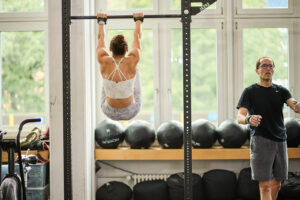
If you’ve been exercising regularly but feel like you’re stuck in a plateau—or if you’re new to fitness and want the biggest return on your time—there’s one approach backed by both science and experience: high-intensity training.
High-intensity training isn’t just another fitness trend. It’s a highly effective way to build strength, improve endurance, sharpen your brain, and even extend your health span.
That’s why CrossFit has built its entire methodology on it.
CrossFit is constantly varied functional movements performed at high intensity.
Let’s take a closer look at what that means—and why intensity is the game-changer in your fitness journey.
What is high-intensity training?
High-intensity training (HIT or HIIT) refers to workouts that challenge your cardiovascular and muscular systems by pushing you close to your personal limits. It’s not about going all-out all the time or competing with others. It’s about training at a level that creates adaptation.
Unlike long, steady-state workouts, high-intensity training triggers powerful responses in the body:
- Increased cardiovascular fitness (VO₂ max)
- Boosted metabolism and improved insulin sensitivity
- Greater fat loss and lean muscle development
- Enhanced cognitive function and mood
- Slower aging at the cellular level
These benefits are well documented—and not just in the gym. Biomedical scientists have studied the effects of intensity on brain health, metabolic function, and aging.
“Vigorous-intensity exercise increases the production of brain-derived neurotrophic factor (BDNF), which plays a major role in neuroplasticity—the brain’s ability to grow and adapt.”
— Dr. Rhonda Patrick
In her deep-dive on the topic, Dr. Patrick explains how high-intensity training improves not only body composition and fitness, but also brain health and longevity. You can watch the full episode here:
Watch the video: The longevity and brain benefits of vigorous exercise
Why CrossFit uses high-intensity training
CrossFit doesn’t use high-intensity training as a gimmick—it’s the foundation of the methodology. But CrossFit adds structure and purpose by combining intensity with variety and functional movement:
- Constantly varied – Each day’s workout is different, which avoids stagnation and builds well-rounded fitness.
- Functional movements – Exercises mimic real-life actions: squatting, pulling, carrying, jumping, lifting. These movements train you for life.
- High intensity – The pace, load, or complexity is adjusted to be appropriately challenging for you. Intensity is relative, not absolute.
This combination builds strength, resilience, and adaptability. And it does so in far less time than traditional gym routines.
The missing ingredient in most training: intensity
Many people train consistently—but not intensely enough to stimulate change. They move through workouts without pushing their limits, which may feel good in the moment, but often results in frustration over time.
High-intensity training is what moves the needle. It forces your body to adapt: stronger muscles, improved lung capacity, sharper focus. You begin to perform better in everyday life—not just in the gym.
And the best part? These changes happen faster than with low-intensity methods.
But is it safe?
This is a common concern—and a valid one. Intensity without structure can lead to burnout or injury. That’s why proper coaching is essential.
At a professionally run CrossFit gym, high-intensity training is introduced progressively and safely:
- Mechanics first – Learn how to move well
- Consistency second – Repeat good movement patterns
- Intensity last – Only after the first two are established
Workouts are scaled to match your current fitness level. That means beginners and advanced athletes can train side-by-side—each working at their own version of “intense.”
Intensity in this context doesn’t mean extreme. It means intentional.
Long-term benefits of high-intensity training
High-intensity training isn’t just about what it does for you today. It’s an investment in your long-term health and independence.
Studies have shown that high-intensity workouts can:
- Preserve muscle and bone density into old age
- Improve balance and reduce fall risk
- Sharpen cognitive function and protect against neurodegeneration
- Support healthy blood sugar, cholesterol, and blood pressure levels
- Reduce inflammation and biological markers of aging
In other words: you’re not just training to look or feel good now. You’re training to age better.
Efficient and effective for busy lives
Another huge advantage of high-intensity training? It saves time.
Because the workouts are short and potent, you don’t need to spend hours at the gym to see results. Three to five 45-minute sessions per week is often enough to make meaningful progress.
That’s why high-intensity functional training works especially well for busy professionals, parents, and anyone trying to balance fitness with real life.
Ready to experience what intensity can do?
High-intensity training delivers more than a good sweat. It delivers lasting change—physically, mentally, and metabolically.
You don’t need to be in shape to start. You just need to start.
Join us for a free consultation and learn how CrossFit helps people of all backgrounds train with purpose, push their limits safely, and feel better for life.




